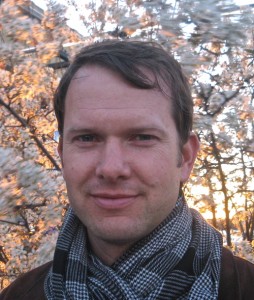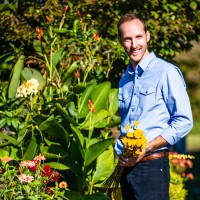Sustainable Design for the 21st Century: The Gillette Forum
by Jonah Holland, PR & Marketing Coordinator, Lewis Ginter Botanical Garden
Next week’s Making Beauty Sustainable: The Charles F. Gillette Forum opens up some great questions about how, as a community, we will design our gardens for the future. As part of this discussion, Lewis Ginter Botanical Garden is bringing in four experts, with different ideas about how to tackle these big real world issues: balancing the desire for native plantings, non-natives that have graced our landscapes for years, and the uncertainty of the future climate.
By examining the critical processes of plant ecology and applying them to landscape and planting design, we hope to inspire a dialogue about how to responsibly design, install, and manage our green spaces to mitigate climate change.
This is a topic that’s important in large-scale commercial design, but as Doug Tallamy and others have pointed out, it’s just as important in the hundreds of thousands of backyards in this world. So whether you are a commercial landscape designer or a avid backyard gardener, we welcome you to join the conversation with the experts next Thursday evening and all day on Friday. The conversation will be lively, and we promise you will learn something too!
Speakers include Sheila Brady, principal, Oehme van Sweden and Associates, Inc., Travis Beck, author of Principles of Ecological Design and Director of Horticulture, Mt. Cuba Center Inc., landscape designer, teacher, GroundedDesign blogger Thomas Rainer, and Adrian Higgins, garden writer and editor at The Washington Post.
Here are a few excerpts from our featured speakers to get you thinking about sustainable design and the future of gardening.
On Sheila Brady’s work: The garden [New York Botanical Garden’s new native plant garden] rejects a conventional idea of presenting native flora as replicated eco-systems and instead gathers American plants with a gardener’s eye for color, texture, combinations, seasonal peaks and other aesthetic ambitions. The planting schemes are complex, and besides the mind-boggling number of plants involved — 90,000 perennials, grasses, bulbs, shrubs and trees in a 31 / 2-acre area — Brady and her collaborators have used varieties bred for improved garden performance.
In an age of environmental woe — climate change, habitat loss, threats to beloved pollinators — should we change the role and the look of our gardens?
One of the most beautifully planted and instructive dry gardens remains the Gravel Garden at Chanticleer Garden in Wayne, Pa. Here a whole hillside has been converted into a series of landings through a sea of perennials, herbs and grasses. Dry gardens come into their own in late summer. At Chanticleer that has meant a September when the feather reed grass is a rich wheat color against the repeated drifts of the purple aster variety called October Skies. These are just two of dozens of herbaceous plants that carry special appeal in late season, including the wispy grass called nassella, goldenrods, other asters, yuccas, salvias and perhaps some lingering hardy ice plant varieties…..
The other great aspect of the dry garden is that bulbs love it; they get the baking they need during summer dormancy to flourish and multiply. This mimics the conditions of their arid, upland habitats of Asia Minor.
Landscapes are critical to our well-being. From cloud-strewn rangeland to urban streetscapes, they feed and shelter, nurture and amaze us.
In all landscapes, human action and natural processes combine. Wilderness is now designated, no longer de facto. In even the most tended garden myriad insects and seedlings appear.
Successful, sustainable landscapes result when we align our efforts with natural processes. Such landscapes flourish without constant care and support life within and beyond their boundaries.
A network of these landscapes could serve our needs, restore ecological function, conserve biodiversity, and be a delight to inhabit. Such a network can only be built piece by piece. As designers and managers of landscapes, that is our work.
This year on this blog, I have started to celebrate the idea and expression of contemporary naturalistic design. I have made the claim that naturalistic design may be in a golden era. To show the diversity and complexity of this idea, I plan to highlight the work of several leading practitioners.But my enthusiasm was given pause this week after reading Michael King’s thoughtful essay “Never New Gardening.” Michael makes the claim that when it comes to the New Perennial movement (and other gardening movements generally), there is nothing new under the sun.
Here at the Garden we are changing our practices too. Two great examples of that are the new Cherry Tree Walk around Lake Sydnor featuring bountiful native plantings and grasses around the water’s edge that will help filter water before it enters the lake. At the Conservatory, we replaced 9,000 square feet of turf with 2,000 native grasses that encourage wildlife and are better for the environment. As we continue to build new garden areas look for this sort of sustainable landscaping to continue at Lewis Ginter Botanical Garden. We hope that we inspire you to rethink your yard too.
Interested in joining the conversation? Register now, a limited number of spaces are still available for Making Beauty Sustainable: The Charles F. Gillette Forum.
The Garden would also like to thank Presenting Sponsor: 3north, and Supporting Sponsor: The Davey Tree Expert Company, Inc. and The Care of Trees for their generosity in supporting the Gillette Forum.
The Charles F. Gillette Forum on Landscape Design honors the legacy of Charles F. Gillette, a leader in the field of landscape architecture, by engaging the public and the design profession in a conversation about the importance of landscape design and the value of Gillette’s ideals of elegance, superb craftsmanship, and seamless blending of architecture and garden.
Follow up the Gillette Forum by touring some of Richmond’s important urban landscapes during the first What’s Out There Weekend Richmond, presented by The Cultural Landscape Foundation, October 25 and 26. Tours are free, but registration is required.



